Also - See photos and comments from the 2005, 2006, 2008, 2009 CES & ICCE |
Click on photos to see enlarged versions |
Pre-show - "Innovations" |

| Logitech Harmony 1000 - they are aiming this at a slightly more upscale market than their 890 remote control model. This is for two-handed operation and is touch screen-based. Companies like Crestron and Philips have touch panel remote controls that are more expensive. The Harmony 1000 is $499, available late January. | 
| The Fastap keyboard places raised alpha keys in the corner spaces of the number pad. They claim that it is about 3 times faster than a standard phone keypad for most people to type out a message. It is available in limited areas today, but will soon be available nationwide. |
| Eclipse will be offering a car audio unit that integrates a removable Tom Tom GPS navigator. It fits into a double-DIN slot, so it looks better integrated into the car. Available in May for under $1,000. | 
| Emtrace WidgetStation is an Internet-connected clock that also displays information from widgets such as weather, news, or even photos from your Flickr account. Price and availability are TBD based on an evolving go-to-market model. | 
|

| Wow Wee will be offering a singing Elvis head for fans that just have to have it all. 10 motors control facial movements. They studies lots of Elvis footage to get the moves down. The company has to get approval from the Elvis estate for every song they implement. Expect this in August for about $349. | 
| Does your 10 year old need a 42 inch 1080p HDTV in a fire truck? If so, you can now order a handmade model from Hannspree for just $15,000. |
| Want to listen to your iPod in the bathtub or swimming pool? This $149 case from Ego does the trick. | 
| Here is another of the many iPod accessories at CES - Matsunichi has a pair of docking stations for your video iPod. See the video on a bigger screen, including on your TV. Both models available in March. $130 for the one on the left, and $250 for the one on the right. | 
|

| Last year Celestron offered a a clever way to identify objects in the sky. This year their VistaPix IS70 connects a 3.1 Megapixel camera to a x24 lens for $479. | 
| Hotseat Flight Sim is the ultimate flight simulator or race car driver gamer. $3,954 gets you the PC, chair, 5.1 sound with subwoofer under your seat, Microsoft Flight Simulator 10, display, steering wheel and foot controls. |
| Seamless Internet offers the S-Xgen handheld Pocket PC 3-band GSM phone with WiFi and fold-up keyboard. Nice try, but still a bit bulky. $1,395 this March. | 
| Every year another 3-D glasses display comes out. Now you can see it in 720p HDTV resolution from TDVision. $500 in April. Realtime software can translate computer graphics, or you can use their 3-D video camera that records MPEG4 720p video onto SD flash cards. | 
|
Pre-Show Press Conferences
(click on photos to enlarge) |

| Probably the single most important product introduction at CES. While we knew it was being worked on, seeing LG's finished Blu-ray/HD-DVD combo player in person finally changes the stalemate between the two formats. LG calls it "Super Multi Blue". Now the single-format players begin to look a little narrow, and the consumer doesn't have to care that all the studios aren't behind a single format (Universal supports HD-DVD, while all the others support Blu-ray or both). The player is model BH100, and will retail for $1,199, Q1 of 2007. It is 90% there - the interactive iHD (for HD-DVD) is not fully supported, while BD-J (Blu-ray) is. However, their GGW-H10N combo drive for the PC does support both interactive languages. The PC drive can write Blu-ray, but does not appear to write HD-DVD. While LG has not talked to other manufacturers yet, it would not be surprising to see more combo drives in a year from others. The iHD omission should also be solved in time. |
| First LG came out with a huge plasma, then Samsung upped the ante, and then Panasonic did it one inch better with 103". Meantime, everyone said LCD panels were not ready for the big display. Now Sharp has proven this wrong with a 108" LCD panel. This will be a real product this summer. | 
| A few years ago Panasonic promised an HDTV camcorder than would record to an SD card. First they came out with a professional camcorder that used PCMCIA-sized cards. Now they have finally introduced their consumer camcorder that records to SD. It goes by the name AVC-HD. | 

|

| Philips showed their special
1 millionth Ambilight TV, with diamonds in the frame. | 
| Cute little audio books that are based on MP3 players. You buy them at book stores like Borders for about the same price as audio book CDs. Comes with ear buds, too. |
| Microsoft showed a new "Live" program that lets you use your XBox game controller to fly through cities. The images come from satellite images, much like Google's maps. The second picture to the right shows how Vista lets you easily combine the photos from two different shots into one. This way, if someone is blinking during one shot you can substitute the face (eyes) from another shot. Photoshop can do this with some effort, but not automatically like Vista. | 
| 
|
Day 1 of CES
(click on photos to enlarge) |

| One of the more intriguing technologies that Samsung talked about is what they call A-VSB. U.S. digital television uses 8-VSB modulation which has very poor mobile performance compared to Europe's standard. A-VSB works over existing DTV broadcast equipment, but uses about 30% of the bit stream to send a training signal and a forward error correction (FEC) signal. The training signal helps to tune the receiver's equalizers while the FEC fixes the rest. The photo on the left shows before and after images while the photo on the right is a prototype receiver. The system is in development, but one can see implications for some alternative cellular-based TV mobile services. | 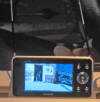 |
| The Samsung K5 lets you get out of the "ear bud bubble" by playing your MP3 out loud. The speaker panel (rear panel) fold away when not used. The K5 sells for $199 and up, depending on memory. | 
| The Samsung Pocket Imager is a 50 lumen LED powered pocket projector that they claim can work on a 100" screen (a 40" screen was shown in a dark room and it was acceptable). The most likely use is for small business meetings. SVGA resolution for about $700 this February. | 
|

| A very clever pair of mice from MoGo for the notebook traveler. They fit into the peripheral slot (e.g. PCMCIA or ExpressCard/54) for storage and charging. They pop out and up to be your Bluetooth wireless mouse. Somewhat comfortable, but cool design. The newer (left) model comes out Q2 for $79.99. It features a scroll bar, too. A very small $49.99 Bluetooth dongle will also be available. | 
| Taking their Ambi theme a step further, Philips showed their AMBX game peripheral system. Look closely and you see that environmental lights glow with the mood of the game, while fans blow air on you as required by explosions and speeding cars. A rumble wrist pad is included. The premium kit is $399. Next year they will have vest you wear that lets you know you've just been tackled in a football game (no joke). |
| The Australian Simulation Control Systems company wants to sell you the Dream Machine, a whole body computer game control system. It will be available in May for $1500. | 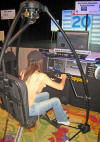
| EPOS makes technology that can be used to make an electronic pen. The device clipped to the top of the pad reads the pen as you write. You unclip that device and plug it into a USB slot and download the "ink", apply handwriting software and get your text file. An un-named company will be introducing one in Q2 for $80. |  |
|
|
Day 2 of CES
(click on photos to enlarge) |
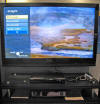
| Panasonic demonstrated EZsync, a way to control multiple devices that are connected via HDMI. Other vendors were also talking about their versions, which tended to be given proprietary names. While this control protocol is a standard, companies tend to use the standard's flexibility to add proprietary extensions. Thus, while you should be able to control a brand B device via a brand A remote, the proprietary elements get in the way. | 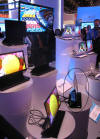
| This photo shows a set of Sony OLED displays. OLED has been used in very limited applications so far, such as the display on cameras. These Sony displays are now up to 27" (1080x1920) and are yet very very thin. Look closely at the one circled in the lower right corner to see just how thin. These are prototypes and Sony did not give availability or pricing. |
| Sony also shows a refreshed version of their GPS Image Tracker. The GPS unit (circled in lower right) takes a reading every 10 seconds. Readings are stored and transferred to your PC. The photos also have time stamps. A comparison lets software show the photo you took and where in the world you were when it was taken. Of course, one needs to make sure the GPS can read the satellites - an issue for indoor photos. | 
| Hitachi showed a clever way to make autostereoscopic (3D) displays that don't need special glasses. Two LCD planes are spaced about 7mm apart and the same image is shown on both. However, parts of the image that are closer to you are brighter on the front LCD, while objects that are far away are brighter on the 2nd LCD. Works pretty good if you are directly in front. Look closely at the paper prop to perhaps get an idea. First use? Pachinko machines. | 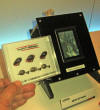 |

| Sonic, a leader in DVD authoring and burning, announced Qflix - a way to burn DVD movies at home or in kiosks. A subtle issue that Sonic negotiated only recently after 3 years of effort is the ability to burn these DVD with CSS on them. Thus, they are very similar to the DVDs you buy at the store. The photo shows one kiosk version that can cost about $1.5 - 5K. Home users would use their PC. It takes about 10 minutes to burn. Only single layer DVDs work a the moment. | 
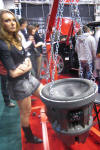
| A quick walk around the "mobile electronics" area discovered a new home theater format - the back of your Toyota SUV. Scosche showed this demo show car. MTX Audio had their own demonstration car, but the speaker in the second photo was what caught our eye. |
Day 3 of CES
(click on photos to enlarge) |
| HP is moving back into its comfort zone with PC oriented products. Here we have the TouchSmart PC, intended for the kitchen as a family organizer. While a keyboard can be used, family management features are accessed via the touch screen. $1799, end of January when Vista is released. | 
| Luxiium offers a unique keyboard that controls the color of each key individually via software. Aside from the visual effects that may appeal to some, a practical application can be when used by application programs to point out groups of keys to focus on during data entry. MSPR is $129. | 
|

| Brainic plans to introduce their VIT Wave this summer. It is an MP3 player with display that "clips" onto your hand. Bluetooth wireless ear buds let you listen to the music while vibrations from the music are felt on your hand. $160. | 
| Tired PC of microphones sticking in you face? AV-TG has a line of microphones for your PC that don't look like microphones. The photo shows a few examples. About $10 to $100, depending upon design. |
| Now the keychain that vendor gives to you can flash the vendor's logo. The flashing is powered by a thin solar power strip on the side of the keychain and will flash for 10 years. $0.80 each (5K minimum order). | 
| No, this is not an 85" SXRD TV from Sony, even though it is styled similarly. It is, however an 85" LCOS TV from KHD. Uses a 200W UHP lamp and is 28" deep. Vendor thinks retail will be between $12 - 18K. | 
|
Day 4 of CES
(click on photos to enlarge) |
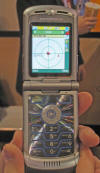
| Trimble Navigation formed Trimble Outdoors at the end of 2004. They offer various services that use the GPS in your phone. For example, AllSports can be useful for finding and guiding you through trails. GeoCache helps you find where a cache is hidden (photo). Guideworx will soon be offered to give turn-by-turn driving via audio commands ($9.99/month). Works with Verizon today. | 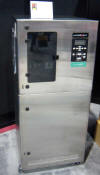
| For an unusual entry in CES, Gridpoint showed their Connect C36-10-2. This product manages a home's power grid, including power you might be generating yourself with solar collectors. It also has backup power. $10,995. |
| Does this guy look a little clueless? If you like shoot-em up games with immersion glasses, look at Trimersion. This product comes out in February for $395. | 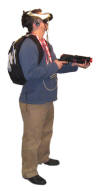
| If you like very small PCs with a complete keyboard, take a look at OQO Model 2. | 
|
ICCE - International Conference on Consumer Electronics
Offers a peak into what the Research labs have been thinking about for the future of Consumer Electronics
(click on photos to enlarge) |

| Chua-Chin Wang, et al, from Sun Yat-Ten Univ. in Taiwan and Asuka Semi of Taiwan explained a working handheld DVB-T TV with the ability to instantly plug in an external antenna to switch between mobile and stationary modes. | 
| Ana Vilas, et al, Univ of Vigo, Spain, explained a way to combine several similar web services into one virtual web service accessible via DVB-H. One example is to display traffic information to drivers. |
| Fumio Issiki, Hitachi, explained how to make a low error rate optical pickup unit that works for Blu-ray, DVD and CD. To handle HD DVD would require another lens (as LG did) using current thinking. | 

| Yes, look carefully at this picture of the Las Vegas Convention Center, and you will see snow. | 
|

| Mitsubishi proposes a way for devices to exchange media using formats not previously defined by DLNA. A Mfr. could define a new media format and have devices go to that Mfr's website to download new transcoding software without the consumer knowledge. | 
| Hyo Moon Jeung, et al, Kyungpook Univ, Korea, propose a device that translates IEEE 1394 streams to Ethernet translation for easier interfacing of devices like camcorders to DLNA devices. |
| HPL shows a prototype of an auxiliary display that is used while watching TV. The aux display connects to EPG data from the Internet and can control the TV's tuner. The aux display can contain related program info, etc. | 
| This year's winner of the Sony sponsored IEEE Ibuka award is Tomlinson Holman, Prof. Univ. So. Calif. Among other things, he was instrumental in the definition of 5.1 audio, and is now working on 10.1 audio. One of his students was Grant Imahara, of Mythbusters fame. | 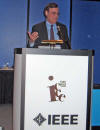
|
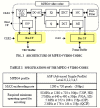

| Sanyo has focused on photo-video cameras for some time. This diagram shows their custom codec that can simultaneously process 720p 30fps MPEG4 video. This was first introduced last year in a camera that could record 720p HD to an SD card and simultaneously take a 5 mega-pixel photo. Sanyo updated this camera this year. | 

| NXP (formerly Philips Semiconductors) explained improved frame rate conversion (FRC) process used for 24 fps to 60 fps (3:2) conversion. Frame interpolation is used to create a smoother progression of images, but "halos" (red outlined areas in photo) result due to missing image data. NXP uses motion estimation to reduce this problem. |
A copy of the ICCE conference proceedings can be obtained at www.icce.org |
See photos and comments from the 2006 CES & ICCE |